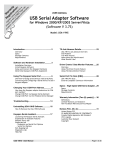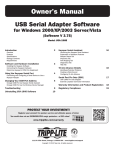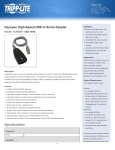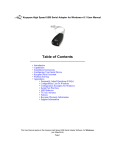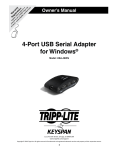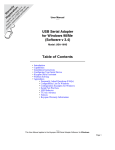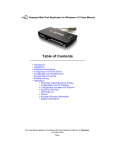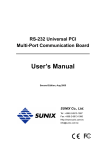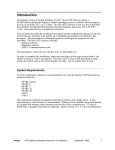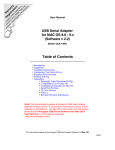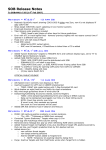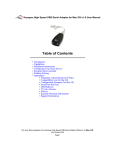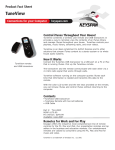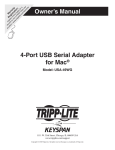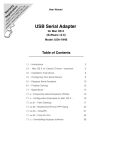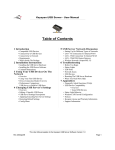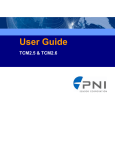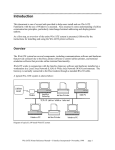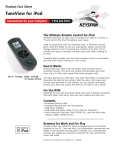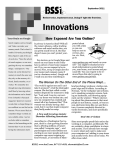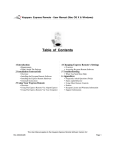Download File - Bryan College Online Help Desk
Transcript
Keyspan Serial Adapter Software
USER MANUAL
for
p/n USA-19HS
Introduction................................................... 2
Overview
Specs
Package Contents
Requirements
Software and Hardware Installation............ 3
Installation Overview
Install Keyspan Software
Setup and Connect the Keyspan Hardware
Determine Keyspan's COM Port Assignment
Using The Keyspan Serial Port.................... 5
Overview Of Using Serial Devices with Serial Ports
Connecting and Configuring A Serial Device To Use A
Keyspan Adapter
Changing Your COM Port Address.............. 9
How does the Keyspan adapter determine its COM
port number?
Change COM Port via Keyspan Serial Assistant
Change COM Port via the Windows Device Manager
Troubleshooting.......................................... 14
TX Ack Advance Details............................. 23
USA-19H Tx Ack Advance Overview
The Problem
The Work Around
Notes about the Work Around
What Should I Use?
Driver Events / Data Monitor Features...... 25
Overview
Using The Driver Events Feature
Using The Data Monitor Feature
Serial Port Pin Outs [DB9].......................... 28
USA-19HS Pin Outs
External Loopback Connector Information
Specs - High Speed USB Serial Adapter... 29
Specs
Package Contents
Requirements
Warranty Information [Two (2) year(s)]..... 30
Definitions
Limited Warranty on Hardware:
How To Obtain Warranty Service/Repair
Uninstalling USA-19HS Software.............. 16
How To Remove the USA-19HS Software
Keyspan Serial Assistant........................... 17
Launching the Keyspan Serial Assistant
Explanation of Assistant Features
Adapter Status tab
Properties tab
- Endpoints and Serial Port Options
- Serial Test Options
Port Mapping tab
Diagnostics tab
Help Tab
USA-19HS - User Manual (rev 3/11/08)
Notices FCC, CE, etc.................................. 31
United States FCC
CE MARK DECLARATION OF CONFORMITY
Canada Digital Apparatus EMI Standard
VCCI (Japan)
Australia/New Zealand
Copyright
Trademarks
Support........................................................ 34
Support Options (US Based)
International Support Options
Page 1 of 34
Introduction
Overview
Keyspan's USB to Serial Adapter technology allows you to connect serial devices to computers that
lack serial ports.
Keyspan's drivers and firmware provide software addresses (COM ports on Windows and Serial Ports on
Mac) for your devices to access.
Our USA-19HS is broadly recommended by serial device manufacturers due to its dependability and
"Best in Class" compatibility. The adapter is compatible with all RS-232 serial devices including modems, GPS devices, cell phones, hand held scanners, networking equipment (console port), graphics
tablets, point of sale devices, touch screens, UPS devices, medical and scientific instruments, industrial process control devices, building automation instrumentation and other serial devices.
Features include:
•
•
•
•
•
•
•
•
•
•
Certified: Microsoft WHQL approved
High Speed: Supports 230 Kbps - twice the speed of a built in serial port
Detachable Cable: Use adapter with any USB cable (up to 5 meters long)
LED: Shows adapter status and data activity
Plug & Play: Appears as standard COM port
Mobile: Easy to carry - weighs just 2 oz.
Bus Powered: No external power adapter required
Analytic Tools: Includes Windows line monitor and data trace software
Field Upgrade: Easy to update over time with free software downloads
Easy Expansion: Supports use of multiple adapters on one PC
Specs
• Connects to USB port on PC or Mac
• Provides one male DB-9 RS-232 port for direct connection to serial device
• Supports data rates up to 230 Kbps
Package Contents
• USA-19HS USB to serial Adapter
• USB Cable
‣ A to B cable (3 foot)
• CDROM (includes software and electronic user manual)
Requirements
•
•
•
•
an available USB port
Mac OS: 8.6 - 9.2.2
Mac OS X: 10.2.8, 10.3.x, 10.4.x, 10.5.x
Windows: 98, 98SE, Me, 2000, XP, Windows Server 2003 x86, Vista (32bit and 64bit)
USA-19HS - User Manual (rev 3/11/08)
Page 2 of 34
Software and Hardware Installation
Installation Overview
Installation is 3 part process where you will 1) install the Keyspan software, 2) connect your adapter,
and 3) determine your adapter's COM port assignment. This last step is important because this is
COM port that you will tell your serial device to use. Please follow the instructions below to complete this process
Install Keyspan Software
Important Notes:
DISCONNECT your Keyspan adapter BEFORE install the Keyspan software.
1. Install the Keyspan Software:
CDROM Installation:
Windows will automatically open the Keyspan CD Browser window (Note: you can manually start
the CD browser by locating and running the "Launch.exe" program on the CD-ROM). Using the onscreen menus, locate the Keyspan Installer selection and click it to start the installation process.
Follow the instructions on-screen.
Installation via download:
Download the Keyspan driver from Keyspan's website (http://www.keyspan.com). Find and
download the Keyspan USA-19HS installer. When you have downloaded the installer, run installer.
WINDOWS Vista Tech Note:
During and/or after the software installation, Windows may report ''Windows can't verify the publisher of this software'', click the ''Install this driver software anyway'' selection.
2. Follow the installer's onscreen instructions to finish the software installation. When the installer
completes, proceed to the Step 3 (Setup Hardware).
Setup and Connect the Keyspan Hardware
3. Connect one end of the USB cable to the USB port on the back of the Keyspan adapter. Connect the
other end of the USB cable to the USB port on your computer. When you connect the adapter,
Windows will detect your Keyspan adapter. During this time, you may see Windows messages appear and disappear showing the names of different components of the Keyspan adapter. This is
normal during the the first installation of your adapter.
WINDOWS Tech Note:
During and/or after the hardware installation, the Windows New Hardware Wizard may ask you to
install software several times. Select ‘Install the software automatically’. You may also get an
additional prompt regarding logo testing, click ‘Continue Anyway' if it appears. Note that you
may get this message several times. Continue through all the Hardware Wizards that appear until they stop appearing (you may see up to 3 Hardware Wizards).
4. When Windows has finished the installation of drivers for your adapter, proceed to the Step 5 (Determine Keyspan's COM Port Assignment).
USA-19HS - User Manual (rev 3/11/08)
Page 3 of 34
Determine Keyspan's COM Port Assignment
5. We now need to determine which COM port was assigned to the Keyspan adapter. The adapter's
COM port is important because you will be telling your serial devices (ie modem, PDAs, GPS, etc)
to use the Keyspan COM port. You can determine Keyspan's COM port assignment by using the
Keyspan Serial Assistant utility. Open Keyspan Serial Assistant utility (START menu > (All) Programs > Keyspan > Keyspan Serial Assistant). You will be presented with the following window:
Keyspan Serial Assistant window
6. In the Keyspan Serial Assistant window, you will see your adapter's COM port assignment. You
should see COMxxx : IDLE or COMxxx: BUSY.
Note the COM port address (ie COM1, COM2, etc) as you will need this information later.
IDLE message:
If you see the IDLE status message, the Keyspan adapter is working and waiting for some program to access the Keyspan COM port. This is the normal state of the adapter. If you look at
your adapter's status light, it will be blinking slowly (1 blink per sec.) to indicate that it is idle.
Proceed to the Making Your Keyspan Adapter Work With Your Serial Device section.
BUSY message:
If you see the BUSY status message, the Keyspan adapter is working and some program has already gained access the Keyspan COM port. If you look at your adapter's status light, it will be on
(not blinking) or blinking every time data is sent or received (this can be a rapid blink or a blink
every couple of seconds). Assuming that your serial device's software gained accessed to the
Keyspan adapter, you should be able to start using your serial device right away. In some cases,
it may be another program that is accessing the COM port before your serial device has had a
chance to get to the COM port. In these cases, please read the Troubleshooting section in this
manual for further assistance.
No Keyspan Adapters Detected message:
If you see the No Keyspan Adapters Detected status message, there is a problem with the installation. Please read the Troubleshooting section in this manual for further assistance.
If you see either the IDLE or BUSY message, proceed to the Using Your Keyspan Serial Port section
later in this manual.
USA-19HS - User Manual (rev 3/11/08)
Page 4 of 34
Using The Keyspan Serial Port
Overview Of Using Serial Devices with Serial Ports
Using a serial device with any serial port requires:
•
•
•
•
•
[hardware] serial device (ie a modem, glucose meter, GPS, etc).
[software] software that sends/receives data from your serial device (ie your GPS software).
[hardware] a serial port (provided by your Keyspan adapter).
[software] a COM port provided by the Keyspan software.
[setup]
your serial device's software needs to be told to use the Keyspan COM port.
This chapter will show you how to use the Keyspan adapter hardware and software. It will also provide an overview of how to setup your serial device.
Note:
Please note that this chapter assumes that you have completed the steps outlined in the Software
and Hardware Installation section earlier in this manual.
Connecting and Configuring A Serial Device To Use A Keyspan Adapter
The basic outline to connecting and configuring your serial device to use the Keyspan are:
1. Connect your Keyspan adapter to your computer's USB port.
2. Connect your serial device to the Keyspan adapter.
3. Determine the Keyspan COM port via the Keyspan Serial Assistant
4. Open your serial device's software and tell that software to use the Keyspan COM port
5. Tell you serial device's software to 'communicate' with the serial device (ie start using the serial
device like you would normally.
For example, if your Keyspan adapter is assigned to COM6, you need to tell your serial device's software to use COM6. The serial device's software is the program that you run to send/receive data
from your serial device. This is where you need tell that program to use the Keyspan COM port.
Please refer to your software's instruction manual for information on how to select a COM port. If
you do not have this information, feel free to contact Keyspan support as we may have this information documented.
Important Note:
If you find your program's COM port selection screen and find that it does not allow you to select the
Keyspan COM port because its port selection screen is limited (ie your software only shows COM1
through COM4 but your adapter is on COM8), you will need to change the Keyspan COM port address.
Please read the Changing Your COM Port Address section later in this manual.
Once you have installed the Keyspan software and connected the Keyspan adapter [hardware] to your
computer, you are ready to connect your serial device hardware to the Keyspan adapter's DB9 port.
1. Connect your serial device's cable to the Keyspan adapter's DB9 port.
USA-19HS - User Manual (rev 3/11/08)
Page 5 of 34
DB9 port on USA-19HS
Note:
If your serial device has a different connector, you may need a converter cable or adapter to connect
your device to a DB9 port. Please contact the manufacturer of your serial device for details.
Now that you have physically connected your serial device to the Keyspan adapter, we need to connect your serial device's software to the Keyspan COM port (software). Before we can do this, we
need to determine the Keyspan COM port. If you already know the Keyspan COM port, skip Step 2.
2. Open Keyspan Serial Assistant utility (START menu > (All) Programs > Keyspan > Keyspan Serial Assistant). You will be presented with the following window:
Keyspan Serial Assistant window
Alternate Method:
You can also use the DEVICE MANAGER in Windows to determine the Keyspan COM port. COM ports
are shown in the Device Manager under the PORTS (COM & LPT) section.
Write down the COM port shown in the ADAPTER STATUS tab. We will need this in the next step. You
can close the Keyspan Serial Assistant when you have noted your COM port.
Note:
COM ports are assigned on the basis of what COM ports (software addresses) are available on your
computer. Because of this, your adapter may be assigned to COM3 on one computer and the same
adapter will be assigned to COM9 on another computer.
COM port addresses can be reserved by software. Microsoft typically reserves COM1 and COM2 on
most Windows 2000, XP, and Vista computers. Devices such as internal modems, Bluetooth devices,
and other USB to serial adapters will also reserve COM ports. This topic is discussed in more detail in
the Changing Your COM Port Address section later in this manual.
USA-19HS - User Manual (rev 3/11/08)
Page 6 of 34
3. Open your serial device's software. This is the software that you would normally use to communicate with your serial device. We need to tell this software to use the Keyspan COM port (from
Step 2). Normally, this is found in a COM port selection screen, menu, etc. Please see your serial
device's manual for instructions on how to select a serial port. Once you find this screen, proceed to the next step.
Note:
Every serial device COM port selection screen is different. Some serial device's have COM port selections in a control panel, some have their COM port selection screens in menu's called Settings, Communication, Preferences, etc, and others may not have a place to select a serial port. If you do not
know how to access your serial device's COM port selection screen and you cannot get support from
your serial device's manufacturer, please note that Keyspan FAQ pages have instructions on how to
access and configure many popular serial device's and software. You can access our FAQs via our support web page at http://www.keyspan.com/support/
4. In your serial device's COM port selection screen, select the Keyspan COM port (the one that you
noted in Step 2).
Note:
If your software shows a limited number of ports and your Keyspan COM port is not in that range, you
will need to either get updated software that can see all COM ports or you will need to change the
Keyspan COM port to one that your program can use.
If you need to change your Keyspan COM port, see the Changing Your COM Port Address section later
in this manual. When you have completed that section, return to this section
5. Now that you have selected the Keyspan COM port, start using your serial device like you would
normally.
If your serial device is working, congratulations.
If your serial device doesn't work, please read the Troubleshooting section in this manual for further assistance.
The Keyspan Adapter's Status Light
The Keyspan USA-19HS comes equipped with a green status light. This light reports the status of your
Keyspan adapter. It is useful in troubleshooting various issues.
The following table shows all of the possible states of the status light and what they mean:
Color
State
n/a
Off
Description
The Keyspan adapter is not connected or not receiving power
from your computer.
The Keyspan hardware may not
have been installed correct. See
the troubleshooting section for
details.
USA-19HS - User Manual (rev 3/11/08)
Page 7 of 34
Color
State
Green
On - Blinking Slowing
(1 blink per second)
The Keyspan adapter is IDLE and
waiting for your serial device's
software to access the Keyspan
COM port. This is normal state.
Green
On - Steady Light
(Not Blinking)
The Keyspan adapter is BUSY / 'In
Use'. The adapter is being accessed by some serial device's
software.
Green
On - Blinking Fast or 'Randomly'
The Keyspan serial port is sending
and/or receiving data
USA-19HS - User Manual (rev 3/11/08)
Description
Page 8 of 34
Changing Your COM Port Address
Overview
In some cases, you will find that your serial device's software does not look for all COM ports on your
system. For example, some programs will only look for COM1 through COM4. If your Keyspan COM
port is above your software's range, your software will not be able to see your serial device. In this
case, you have two options:
• upgrade your software to a version that can see all COM ports (recommended)
• change the Keyspan COM port address.
Keyspan recommends that you at least try to get the latest version of your serial device's software
before attempting to change the Keyspan COM port since most developers have upgraded their software to be compliant with latest Windows serial communication APIs.
Developer Note:
If you are developer and want to make your software find all serial ports, Keyspan has sample code
that can be used for finding all COM ports (whether they are Keyspan COM ports or not). This information can be found in the developers section on Keyspan's downloads page.
If you cannot get newer software for your serial device, your only option is to change the Keyspan
COM port. This guide will show you how to change the Keyspan COM port via the Keyspan Serial Assistant as well provide some details about COM ports in general.
How does the Keyspan adapter determine its COM port number?
Keyspan serial adapters create COM ports in the Windows registry just like the COM ports found on
older computers.
When you first connect a Keyspan adapter, the Keyspan adapter software reads the Windows registry
to find an 'available' COM port number.
If COM1 is not available it tries COM2, COM3, etc., until it finds a COM port number that is available.
If your Keyspan adapter creates COM4, then COM1 though COM3 are 'busy' or have been 'reserved' for
some piece of hardware or software (ie an internal modem, wireless connectivity, etc).
In modern computers (ie post Windows 2000), Microsoft reserves COM1 and COM2. Other things that
reserve COM ports are things like internal modems, internal/external Bluetooth (which usually resever eight COM ports), and other USB to serial adapters.
Notes:
Since every computer is different, you may find that your Keyspan adapter is COM3 on one computer
and COM10 on another computer. To determine your Keyspan adapter's COM port assignment, please
use the Keyspan Serial Assistant.
Change COM Port via Keyspan Serial Assistant
Note: This is an advanced feature that requires you to have Administrator privileges on your system.
1. Open Keyspan Serial Assistant utility (START menu > (All) Programs > Keyspan > Keyspan Serial Assistant). You will be presented with the following window:
USA-19HS - User Manual (rev 3/11/08)
Page 9 of 34
Keyspan Serial Assistant window
This will show your Keyspan adapter and the current COM port number (ie COM4, COM 5, etc.).
2. Click 'Port Mapping' tab. Once you are in the 'Port Mapping' section select or highlight the Keyspan
COM port that you wish to change.
Port Mapping tab with Keyspan Port highlighted
With your Keyspan COM port highlighted, select the new COM port number from the 'COM Port mapping for the selected adapter port' pull down menu.
COM Port Mapping pull down menu
USA-19HS - User Manual (rev 3/11/08)
Page 10 of 34
Once you have selected the new COM port number, the Keyspan software will ask you if you are sure
you want to proceed.
IMPORTANT:
Please note that you can select any COM port you wish however, you may notice that certain ports
are 'in use'. This may mean that there is hardware connected to these COM ports or they have been
reserved for the operating system or other software. Changing the COM port mapping to a COM port
that is 'in use' may render any hardware and/or software using that port inoperable.
3. Your COM port has now been changed to the new COM port number. To confirm the change, click
the Keyspan Serial Assistant's Adapter Status tab to see the new COM port. The COM port change
is complete.
Change COM Port via the Windows Device Manager
On Windows XP and Vista, you can change your Keyspan adapter's COM port number via the Device
Manager. This requires the latest version of the Keyspan software (version 3.7 or later).
This process accomplishes the same task as changing the COM port via the Keyspan Serial Assistant
however certain users may prefer to use the Device Manager to change ports.
Note: This is an advanced feature that requires you to have Administrator privileges on your system.
1. Open Device Manager by double-clicking the System control panel. Next, click the Hardware tab
and then click the Device Manager button. This will open the Device Manager.
Device Manager window
Note: This is an advanced feature that requires you to have Administrator privileges on your system.
USA-19HS - User Manual (rev 3/11/08)
Page 11 of 34
2. In the Device Manager, go to the Ports (COM & LPT) heading and click the on the plus (+) sign to
expand the heading. Find the Keyspan COM port in the list and right-click on the Keyspan USB Serial Port item. Next select Properties.
Opening the Keyspan USB Serial Port Properties
This will open the Properties window:
the Properties window
3. In the Properties window, click the Port Settings tab and then click the Advanced... button as
shown below:
the Port Settings tab and Advanced... button
USA-19HS - User Manual (rev 3/11/08)
Page 12 of 34
This will open the Advanced Settings window:
the Advanced Settings window
4. In the Advanced Settings window, select the new COM port from your the COM Port Number pull
down menu.
the Advanced Settings window
Once you have selected the new COM port number, the Keyspan software will ask you if you are sure
you want to proceed.
IMPORTANT:
Please note that you can select any COM port you wish however, you may notice that certain ports
are 'in use'. This may mean that there is hardware connected to these COM ports or they have been
reserved for the operating system or other software. Changing the COM port mapping to a COM port
that is 'in use' may render any hardware and/or software using that port inoperable.
5. Your COM port has now been changed to the new COM port number. To confirm the change, return
to the Device Manager and locate the new COM port under the Ports (COM & LPT) heading.
USA-19HS - User Manual (rev 3/11/08)
Page 13 of 34
Troubleshooting
This troubleshooting guide will guide you in solving problems with the Keyspan USA-19HS hardware
and software installation.
Before you begin, make sure that you have:
• installed the latest USA-19HS software (available from our website)
• your USA-19HS adapter is connected to your USB port
Note:
If you are downloading software from Keyspan's website, make sure you download the USA-19HS drivers. Keyspan has drivers for other adapters such as the USA-19, USA-19Qi, USA-19QW, etc. These
drivers are not compatible with the USA-19HS.
1. Open Keyspan Serial Assistant utility (START menu > (All) Programs > Keyspan > Keyspan Serial Assistant). You will be presented with a window that looks like the following:
Keyspan Serial Assistant window
<Option 1>
The Keyspan Serial Assistant will show your adapter's COM port and status (ie COMxx:Idle or COMxx
busy).
The IDLE message means that your serial device's software is not currently accessing the Keyspan
port).
The BUSY message means that a program (software) has accessed the Keyspan COM port. In most
cases, this means that you are ready to start using your serial device via the Keyspan adapter. If you
are not able to use your serial device, contact Keyspan tech support.
If your COM port appears, the Keyspan software and hardware is installed correctly. You do not need
to read the rest of this troubleshooting guide. If you are having problems, please contact Keyspan
tech support for further instructions. They will need to know your COM port number and it's status
(IDLE or BUSY).
'
<Option 2>
If the message 'NO KEYSPAN USB SERIAL ADAPTERS FOUND' appears, proceed to Step 2.
2. Look at your Keyspan adapter hardware. On the front of the adapter, it will have the work
Keyspan printed on it. On the back of the adapter, find the printed p/n number (located under
USA-19HS - User Manual (rev 3/11/08)
Page 14 of 34
the FCC and CE symbols).
<Option 1>
If your printed p/n number DOES NOT show USA-19HS, you do not have a USA-19HS. Refer to the
correct documentation for your adapter.
<Option 2>
If your printed p/n number shows USA-19HS, proceed to Step 3.
3. Open the Device Manager:
On Windows 2000, XP, or Vista:
Open Device Manager by double-clicking the System control panel. Next, click the Hardware tab
and then click the Device Manager button. This will open the Device Manager.
On Windows 98, 98SE, or Me:
Open Device Manager by double-clicking the System control panel. Next, click the Device Manager tab.
4. In the Device Manager, we are looking for any Keyspan related item that has a question mark (?),
exclamation mark (!), or red 'X'. You do not need to open every heading. Items with ?, !, and X
will appear on their own.
<Option 1>
Nothing shows up for Keyspan adapter in Device Manager (i.e. no “Other Device” or “TUSB 3410
Boot Device”). In this case, please change another USB cable and connect your Keyspan adapter to
another USB port in your computer. If you still have the same problem, please contact Keyspan
tech support for further assistance.
<Option 2>
Keyspan adapter appears in Device Manager as “TUSB 3410 Boot Device”. This indicates that you
have a defective Keyspan USB Serial Adapter. Stop here and contact Keyspan tech support for further assistance.
<Option 3>
Check the 'Other Devices' heading (you can expand this by clicking on the plus (+) sign next to the
heading) and see if there any items with a question mark (?) or an exclamation point (!). If you
have any items like this, right-click on each one and select the 'remove' or 'uninstall' command
from the right click menu.
Once you have removed all items with a question mark or an exclamation point in Device Manager,
disconnect your Keyspan adapter and restart your computer.
Login as Administrator and disable any anti-virus software when you get back to the desktop. Reconnect the adapter to a built-in USB port and open Keyspan Serial Assistant. Your Keyspan com
port should now show up under the 'Adapter Status' tab. Your Keyspan USB Serial adapter now is
ready to use.
If you still cannot see your Keyspan adapter in the Keyspan Serial Assistant, contact Keyspan tech
support for further assistance.
USA-19HS - User Manual (rev 3/11/08)
Page 15 of 34
Uninstalling USA-19HS Software
How To Remove the USA-19HS Software
Uninstalling the Keyspan USA-19HS software is an easy process in Windows. This process completely
uninstalls all Keyspan software files and entries in your Windows registry. The following process
walks you through the process of uninstalling the Keyspan software.
1. Disconnect the Keyspan USA-19HS Adapter from your USB port.
2. Close any Keyspan program windows (ie the Keyspan Serial Assistant)
IMPORTANT:
Make sure you complete steps 1 and 2. Uninstall will fail if you skip these steps.
3. For 98, Me, 2000, and XP, open the Add/Remove Programs control panel.
For Vista, open the Programs And Features control panel.
4. In the control panel, locate the Keyspan USA-19HS software. Then click the Uninstall/Change button to begin the uninstall program. Follow the instructions on-screen to complete the uninstall
process.
Note:
You may get an additional dialog asking you if you want to Repair, Modify, or Remove the software.
Select Remove and then click the Next button if you see this dialog appear.
USA-19HS - User Manual (rev 3/11/08)
Page 16 of 34
Keyspan Serial Assistant
Besides the required drivers, the Keyspan USB Serial Adapter software installer installs an application
called Keyspan Serial Assistant. This application is used to:
- Determine the status of the adapter software and hardware
- Assist in problem solving
Launching the Keyspan Serial Assistant
Open Keyspan Serial Assistant utility (START menu > (All) Programs > Keyspan > Keyspan Serial Assistant). You will be presented with a window that looks like the following:
Keyspan Serial Assistant window
If your Keyspan hardware and software are installed correctly, you will see your adapter in the
'Adapter Status' tab box. You should also see the COM port number (ie COM1, COM2, etc.) and the
COM Port Status (IDLE or BUSY).
Note:
If you see your COM port number and its COM port Status. If you do not see either of these items,
proceed Troubleshooting section in this manual.
Explanation of Assistant Features
The following is a description of all the relevant text boxes and menus found in the Keyspan Serial
Assistant. You can also obtain this information by turning on the 'Enable Tool Tips' check box in the
Assistant's Help tab.
Adapter Status tab
The Adapter Status tab in the Keyspan Serial Assistant displays the status of your Keyspan adapter.
Specifically, it shows the COM port number (ie COM1, COM2, etc.) and the COM Port Status.(IDLE or
BUSY). If you have several Keyspan adapters of the same type, they will all show up in this tab.
Adapter Status tab
USA-19HS - User Manual (rev 3/11/08)
Page 17 of 34
This is also the first place to check to see if your Keyspan adapter is working properly. If your
Keyspan adapter does not show up in the Adapter Status tab, please proceed Troubleshooting section
in this manual for further instructions.
Properties tab
The Properties tab in the Keyspan Serial Assistant allows has two functions:
• test your Keyspan adapter (via Serial Test Options)
• make changes to the behavior of the Keyspan adapter (Endpoints and Serial Port Options)
Properties tab
Endpoints
Serial Port
Options
Serial Test
Options
Adapter pull down menu
The Adapter pull down menu is used to select which USB Serial Adapter you would like to configure.
If you only have one Keyspan USB Serial Adapter, you will not need to change the selection.
- Endpoints and Serial Port Options
The Endpoints radio buttons are used to configure how the Keyspan adapter will communicate
with the USB subsystem (software)on your computer. Most users will not need to modify the default setting (Compatible (Interrupt)). You should only change this setting if you are sure that your
serial device needs a specific setting. The default setting is Compatible (Interrupt).
Port pull down menu
If you have more than one serial port on your Keyspan adapter, the Port pull down menu allows you
select which serial port you want to modify or test. You can also see the serial port's COM port
number and its COM port status next to the Port pull down menu. If you only have one serial port
on your Keyspan USB Serial Adapter, you will not need to change the selection.
Transmit Completion Timing Advance pull down menu
The Transmit Completion Timing Advance pull down menu allows you to adjust a device's transmit
behavior to achieve the optimum compromise between compatibility (exact emulation of built-in
ports) and improved throughput. The default setting is 'Standard'. Before changing this setting,
read the TX Ack Advance Details section in this manual. This section gives you detailed information as to what this feature does and how it affects serial communication. This setting is set per
port (ie if you have a multi port Keyspan adapter, you can set one port to have one setting and another port to use a different setting). Once you make this change, click the Update Configuration
button to upload the new settings to your adapter.
USA-19HS - User Manual (rev 3/11/08)
Page 18 of 34
Receive FIFO Buffer Size pull down menu
The Receive FIFO Buffer Size pull down menu allows you to configure the number of characters
which are stored in the card's "First In First Out" input buffer ("FIFO") before they are made available to the computer. The default value of this parameter is "16". The Receive FIFO improves the
reliability of data transfer at high speeds. You can turn this option OFF for performance reasons
however this is not necessary in most cases. If you are receiving data from your serial device at
speeds of 9600 baud or lower, you may want to set the Receive FIFO Buffer Size to None. This
setting is set per port (ie if you have a multi port Keyspan adapter, you can set one port to have
one setting and another port to use a different setting). Once you make this change, click the Update Configuration button to upload the new settings to your adapter.
Update Configuration button
The Update Configuration button updates the Keyspan adapter with the changes you have made in
the Properties tab. Please note that these changes will take effect when you click the Update
Configuration button.
- Serial Test Options
The Test This Port button tests the COM port selected in the Port pull down menu (in the Serial Port
Option section in the Properties tab). The test that is performed is the selected test in the Test Option box.
Note:
The baud rate shown here is only used to configure the Serial Test. If your serial device's software
does not provide the necessary port settings to our adapter and you need to specify the default port
settings (ie baud [bits per second], data bits, parity, stop bits, and flow control), you set these settings in the Device Manager (right-click your Keyspan COM port in the Ports (COM & LPT) heading and
then select Properties and then click the Port Settings tab).
Test This Port button
The Test This Port button tests the COM port selected in the Port pull down menu (in the Serial Port
Option section in the Properties tab). The test that is performed is the selected test in the Test
Option box.
Test Mode box
The Test Mode box allows to specify the type of test that will be performed when you press the
Test This Port button. There are 3 types of tests:
TX Only:
Use this test to test only the transmit (Tx) signals of the Keyspan adapter.
Ext. LoopBack:
Use this test sending and receiving data. This test sends data out the selected serial port and
waits to receive it via a special Loopback connector. You can find more information about this
special Loopback connector in the Serial Port Pin Outs section in this manual. IMPORTANT!
This test will fail if you did not make and connect a custom Loopback connector.
Int. Loop Back:
Use this test sending and receiving data. This test is performed within the Keyspan adapter
hardware. This test DOES NOT require a special Loopback cable.
Test Type box
The Test Type box allows to specify how many times the selected test will be repeated when you
press the Test button. Use the Quick option to perform the test once. To perform a subsequent
test, press the Test This Port button. Use the Continuous option to repeat the test continuously. To
USA-19HS - User Manual (rev 3/11/08)
Page 19 of 34
stop the test, press the Stop Test button (the Test This Port button becomes the Stop Test button
during a test).
Test Speed pull down menu
The Test Speed pull down menu allows to specify the speed (baud rate) at which the port will be
tested at when you press the Test This Port button button.
Test Status box
The Test Status box reports the test status or results of the selected COM port.
Port Mapping tab
The Port Mapping tab in the Keyspan Serial Assistant allows you to change how COM port numbers are
assigned to your Keyspan adapter. The following is an explanation of the items in this tab.
Important!!! Changing COM port assignments may render other hardware unusable. For step by step
instructions on how to change a COM port address, read the Changing Your COM Port Address section
earlier in this manual. Please make sure you read the sections about changing COM ports carefully.
Port Mapping tab
COM Port list box
The COM Port list box shows any connected Keyspan USB Serial Adapter, its COM port number and
COM port status. You can also see any other COM port that have been assigned or reserved on your
computer if you enable or check the Show All COM Assignment check box.
Show All COM Assignments check box
Enable or check the Show All COM Assignments check box to display ALL of the COM port name and
numbers that have been registered on your computer. This will include COM ports for other devices.
Note: You may have COM ports assigned or 'set aside' for hardware that may not be installed on your
computer depending on how your computer was setup by its manufacturer.
USA-19HS - User Manual (rev 3/11/08)
Page 20 of 34
COM port mapping pull down menu
The COM port mapping pull down menu allows you to reassign the selected Keyspan COM port in the
COM port list window. This window also reports whether a COM port is 'in use'. In this menu, 'in use'
means that the selected COM port has assigned or reserved. It is highly recommended that you only
change the COM port mapping to COM ports that are not 'in use'.
Note: The COM port mapping pull down menu allows you to change the COM port mapping to any
COM port including those that have already been assigned (aka in use). Changing the COM port mapping to a COM port that is in use may render any hardware and/or software using that port inoperable.
Adapter Port Mapping Mode box
The Adapter Port Mapping Mode box allows you to change the behavior of how Keyspan COM port
numbers are assigned when you connect the Keyspan adapter to a different USB port than the one it
was originally connected to.
Dynamic:
Dynamic assigns a COM port number (or numbers if your Keyspan adapter has multiple serial
ports) to a particular Keyspan adapter. If you disconnect the Keyspan adapter and connect it
to a different USB port, the COM port number of that Keyspan adapter will not change. This is
the default setting and is recommended setting if you only have one Keyspan adapter.
Geographic:
Geographic assigns a COM port number (or numbers if your Keyspan adapter has multiple serial
ports) to a particular USB port on your computer. If you disconnect the Keyspan adapter and
connect it to a different USB port, the COM port number of that Keyspan adapter will change.
This setting is recommended if you are using multiple Keyspan adapters and want the COM port
numbers to remain the same.
Delete All Keyspan USB Serial Adapter Port Mappings button
The Delete All Keyspan USB Serial Adapter Port Mappings button clears the Windows registry of all
Keyspan USB Serial Adapter COM port numbers and Keyspan USB information. This allows Windows to
create new COM port assignments.
Note: that this is an option for advanced users only. If you are unsure about how this command will
affect your computer, please contact Keyspan Tech Support for further assistance.
Diagnostics tab
The Diagnostic tab in the Keyspan Serial Assistant reports diagnostic information about your Keyspan
adapter's software and hardware. This information is useful if you are trying to solve problems with
Keyspan's technical support staff. The following is an explanation of the items in this tab.
Diagnostics tab
USA-19HS - User Manual (rev 3/11/08)
Page 21 of 34
Adapter Status/Error Log window
The Adapter Status / Error Log box displays the status of your Keyspan adapter hardware and software. It detects if the Keyspan driver is installed and whether or not a Keyspan adapter is connected.
Clear Log Window button
The Clear Log Window button will clear the Adapter Status / Error Events box.
Log Debug Events check box
Enable or check the Log Debug Events check box to display all of the Keyspan adapter's debug events
as well as the driver events. This option can be turned on and off.
Open Driver Events Window button
The Open Driver Events Window button will open the Keyspan adapter's Event log window. This window reports all of the events or actions that the adapter is performing. This is useful in troubleshooting data communication problems. This is an advanced feature of the Keyspan Serial Assistant. For
more details on how to use this feature, read the Driver Events / Data Monitor Features section in
this manual. Data from this window can be saved to text file.
Open Data Monitor Window button
The Open Data Monitor Window button will open the Keyspan adapter's Line Monitor (aka Data Monitor) window. The Line Monitor will display all data and all modem control state changes sent to and
from the USB Serial Adapter. This is an advanced feature of the Keyspan Serial Assistant. For more
details on how to use this feature, read the Using Driver Events / Data Monitor Features section in
this manual. Data from this window can be saved as a graphic to your clipboard (and pasted into
most programs [WordPad is a compatible program]).
Help Tab
The Help tab in the Keyspan Serial Assistant displays the version numbers if the different components
in your Keyspan USB Serial Adapter installation. You can also enable Tool Tips (on screen help), read
your Keyspan adapter's User's Manual, or go to Keyspan's home page.
Help tab
USA-19HS - User Manual (rev 3/11/08)
Page 22 of 34
TX Ack Advance Details
USA-19H Tx Ack Advance Overview
Many Keyspan USB serial adapters support configurable "Transmit Acknowledgment Advance" (aka TXACK threshold, aka TX-ACK(nowledgement) advance, etc.) in the Keyspan Manager. This feature allows the user to adjust a device's transmit behavior to achieve the optimum compromise between
compatibility (exact emulation of built-in ports) and improved throughput. This document describes
the factors which a user should be aware of to guide their configuration of this feature.
The Problem
In the case of a standard, "built-in" serial port, the host CPU (the "brain" of the computer) can communicate directly with the serial hardware because the (serial) hardware is in the address space directly accessible to the CPU. When the serial port has transmitted all the data in its transmit FIFO
(the buffer that holds characters waiting to be sent), it interrupts the CPU, which then adds more
characters to the transmit FIFO with a minimal time delay.
By contrast, in a USB to serial adapter, information about the state of the serial port FIFO reaches
the CPU by means of USB messages. The USB subsystem in most computers delays the delivery of inbound (USB peripheral to USB host computer) USB messages by about 1 millisecond. The impact of
this delay on serial throughput depends on the baud rate. At 9600 baud, it takes about 1 millisecond
to transmit a character. If the serial adapter signals the host when it begins transmitting the last
character in its FIFO, the host learns about it at about the same time the character is actually finished being transmitted. Since outbound (USB host computer to USB peripheral) USB messages are not
subject to such a long delay, the host can supply new data before the serial port has been idle for too
long.
At higher baud rates, however, this 1-millisecond delay becomes more of a problem. For example, at
920 Kbps, 1 millisecond is enough time to send 92 characters. So, if you're sending 92 characters at a
time, you will only achieve 50% throughput, since half the time is spent with the adapter waiting for
the host to send more data.
The Work Around
Since there's no way to eliminate the USB delays, there's only one work around: the serial adapter has
to lie about when it's done transmitting. This way, the adapter still has some data to transmit while
it's waiting for more to arrive from the host. If the next data from the host arrives before the previous data is completely sent, the new data can be sent with no delay, and the device will achieve improved transmit throughput.
Notes about the Work Around
In most situations, the serial adapter's lie is harmless or beneficial, even. However, in some circumstances, this lie gets us into trouble. There are several ways this can happen:
Flow control:
If the adapter is programmed to use flow control, the remote (receiving) end of the serial connection
can ask the adapter to suspend its data transmission (e.g. if it's not ready to receive more data).
Since this state can persist indefinitely, the "I'm done" indication, if it were sent early, could arrive at
the host a significant amount ahead of time. As a result, the application might use the "I'm done" signal as an indication that the remote end is ready, leading to various kinds of trouble.
Data flushing:
Sometimes, an application will issue a "transmit flush" command to the adapter get rid of extra data.
For example, let's say that an application sends "AAAA" to the adapter, and then, once it's received
the "I'm done" indication, sends "BBBB." Now, let's say that some time after sending "BBBB," the appli-
USA-19HS - User Manual (rev 3/11/08)
Page 23 of 34
cation decides to cancel whatever part of the "BBBB" has yet to leave the serial port, and sends a
"transmit flush" command to the adapter. If the adapter had been lying about being done sending
"AAAA," it might still not be done, and the flush could purge the transmit FIFO of some of the A's
(which is not what the application was expecting) in addition to the B's.
Timing:
In some applications, the receipt of the "I'm done" indication is used as a timing reference point. For
example, an application could send a data stream like this:
COMMAND................................................................
The extra periods following COMMAND would be just used to establish a timing interval: the application would know that once the serial port said "I'm done," the receiver would have had at least 64
character times to process COMMAND. If the "I'm done" indication was sent early, the application
might then do its subsequent action too early.
There are many other communication protocols in which time periods are counted from the point
that a message has been delivered. Any time you change the timing of the "I'm done" indication, you
run the risk of interfering with such protocols.
What Should I Use?
There are two ways you can configure Tx Ack Advance:
Standard:
If you're using a baud rate of 57600 or less, you probably don't have a problem. The 1 millisecond
delay will not significantly affect your throughput, and you can select this option. This option is also
a good choice if you are running an application in which throughput is not an issue, or one in which
guaranteeing 100% correct operation is important enough that you'd prefer not to risk having problems.
Faster:
If you're using a baud rate above 57600, you can simply try increasing this setting, and see whether it
improves performance (in which case, great!), causes problems (in which case, don't use it), or
doesn't make any difference (in which case it doesn't matter what you do).
USA-19HS - User Manual (rev 3/11/08)
Page 24 of 34
Driver Events / Data Monitor Features
Overview
The Keyspan Serial Assistant's Driver Events and Data Monitor windows provide information as to what
serial data is being sent/received by the Keyspan adapter (the Data Monitor utility) and what Keyspan
specific actions the Keyspan adapter is using (the Driver Events utility).
Both of these features are designed for Keyspan's use in troubleshooting complex issues with serial
communication. If you are having problems with a serial device, Keyspan tech support may ask you
to use one or both of these features.
This section describes how to use these features in terms of gathering data for Keyspan's tech support
and engineering teams. Please note, do not send data to Keyspan unless you already spoken to
Keyspan support about your issue.
Note:
Outside of how to use these features for collecting data for Keyspan support, we do not document
the meaning of the messages shown in these utilities. These messages are generic (in the case of the
Data Monitor) or specific to only Keyspan USB to Serial Adapters (in the case of the Driver Events). If
you have a specific feature request regarding these utilities, please contact Keyspan.
Using The Driver Events Feature
To save data from the Driver Events window:
1. Connect your Keyspan adapter to your computer
2. Open the Keyspan Serial Assistant
3. Click the Diagnostic tab
4. Click the Open Driver Events Window button.
5. The Driver Events window will automatically open and show all Keyspan Driver Events for all of
your USA-19HS adapters.
Drive Events window (with data)
USA-19HS - User Manual (rev 3/11/08)
Page 25 of 34
6. At this point, use your serial device like you would normally. For Keyspan's purposes, click the
Stop button when your serial device fails and proceed to Step 7. Note, you can record as long as
you want but Keyspan only needs data from the point you first start using your serial device to the
point that it fails. If you are keeping this data for yourself, you can record data as long as you
want.
7. Click the Save button to save your file to log. If Keyspan has requested this info, please contact
your Keyspan representative on how best to send this file.
Using The Data Monitor Feature
To save data from the Driver Events window:
1. Connect your Keyspan adapter to your computer
2. Open the Keyspan Serial Assistant
3. Click the Diagnostic tab
4. Click the Open Data Monitor Window button. This will open the Line Monitor window.
5. In the Line Monitor window, a 'COMxx (Channelyy)' window may automatically open for you.
COMxx (Channelyy) window
If you see this window, proceed to Step 6. If not, click the File menu and select the Open Channel
command.
Open Channel command
6. Click on the Go button to begin capturing data.
Go button
7. At this point, use your serial device like you would normally. For Keyspan's purposes, click the Edit
menu and then select the Copy Contents command when your serial device fails and proceed to
Step 8. Note, you can record as long as you want but Keyspan only needs data from the point you
USA-19HS - User Manual (rev 3/11/08)
Page 26 of 34
first start using your serial device to the point that it fails. If you are keeping this data for yourself, you can record data as long as you want.
Note:
Unlike the Data Monitor window, the Line Monitor/Data Monitor window saves data as a graphic only.
Line Monitor/Data Monitor cannot be saved as text at this time. If you are developer that needs this
feature, contact Keyspan.
8. Paste the contents of your data into a Windows program like WordPad (or similar program). You
can then save this file and send it to Keyspan if needed. If Keyspan has requested this info, please
contact your Keyspan representative on how best to send this file.
USA-19HS - User Manual (rev 3/11/08)
Page 27 of 34
Serial Port Pin Outs [DB9]
USA-19HS Pin Outs
The pin assignments for the Keyspan USB Serial Adapter's male DB9 port are illustrated below:
Pin
Name
Signal Designation
1
DCD
DCD Data Carrier Detect (Input)
2
RX
RX Received Data (Input)
3
TX
TX Transmitted Data (Output)
4
DTR
DTR Data Terminal Ready (Output)
5
GND
GND Ground
6
DSR
DSR Data Set Ready (Input)
7
RTS
RTS Request To Send (Output)
8
CTS
CTS Clear To Send (Input)
9
RI
RI Ring Indicator (Input)
In order to ensure compliance with emission specifications, cables should be shielded using braided
shields and metal hoods with complete 100% contact between the shields and hoods.
External Loopback Connector Information
The Keyspan Serial Assistant allows you to perform two types of loopback tests - internal and
external. The external test requires the use of a special loopback connector. This connector
requires a "DB9 Female Loopback plug" with the following wiring:
USA-19HS - User Manual (rev 3/11/08)
Pin (s)
Wired to
Pin(s)
1
<->
4, 8
2
<->
3
5
<->
7, 9
Page 28 of 34
Specs - High Speed USB Serial Adapter
Specs
• Connects to USB port on PC or Mac
• Provides one male DB-9 RS-232 port for direct connection to serial device
• Supports data rates up to 230 Kbps
Package Contents
• USA-19HS USB to serial Adapter
• USB Cable
‣ A to B cable (3 foot)
• CDROM (includes software and electronic user manual)
Requirements
•
•
•
•
an available USB port
Mac OS: 8.6 - 9.2.2
Mac OS X: 10.2.8, 10.3.x, 10.4.x, 10.5.x
Windows: 98, 98SE, Me, 2000, XP, Windows Server 2003 x86, Vista (32bit and 64bit)
USA-19HS - User Manual (rev 3/11/08)
Page 29 of 34
Warranty Information [Two (2) year(s)]
Definitions
The following definitions apply to the terms as they appear in this document:
KEYSPAN means KEYSPAN, a division of InnoSys Inc.
Hardware means the USA-19HS ‘High Speed USB Serial Adapter’ Package
Product means the Hardware and Documentation
Limited Warranty on Hardware:
KEYSPAN’s warranty obligations are limited to the terms set forth below: KEYSPAN warrants this
Hardware against defects in materials and workmanship for a period of...
Two (2) year(s)
... from the date of original purchase. If you discover a defect, KEYSPAN will repair this Hardware
with either new or refurbished parts at no charge. If KEYSPAN is unable to restore your product to
good working order after a reasonable number of attempts, KEYSPAN will, at its option replace or
refund the purchase price of your product. To obtain service under this warranty you must do the
following during the warranty period:
This warranty does not apply to damage caused by accident, abuse, misuse, misapplication, or service (including upgrades and expansions) performed by anyone other than KEYSPAN; if the product has
been modified without the written permission of KEYSPAN; if any KEYSPAN serial number has been
removed or defaced; or if you cannot provide proof of original retail purchase as described above.
THE WARRANTY AND REMEDIES SET FORTH ABOVE ARE EXCLUSIVE AND IN LIEU OF ALL OTHERS,
WHETHER ORAL OR WRITTEN, EXPRESS OR IMPLIED. KEYSPAN SPECIFICALLY DISCLAIMS ANY AND ALL
IMPLIED WARRANTIES, INCLUDING WITHOUT LIMITATION, WARRANTIES OF MERCHANTABILITY AND FITNESS FOR A PARTICULAR PURPOSE. No KEYSPAN Authorized Reseller, agent or employee is authorized
to make any modification, extension or addition to this warranty.
KEYSPAN IS NOT RESPONSIBLE FOR DIRECT, SPECIAL, INCIDENTAL, OR CONSEQUENTIAL DAMAGES RESULTING FROM ANY BREACH OF WARRANTY, OR UNDER ANY OTHER LEGAL THEORY, INCLUDING BUT
NOT LIMITED TO LOST PROFITS, DOWNTIME, GOODWILL, DAMAGE TO OR REPLACEMENT OF EQUIPMENT
AND PROPERTY, AND ANY COSTS OF RECOVERING, REPROGRAMMING, OR REPRODUCING ANY PROGRAM
OR DATA STORED IN OR USED WITH KEYSPAN PRODUCTS.
Some jurisdictions do not allow the exclusion or limitation of incidental or consequential damages or
exclusions of implied warranties, so the above limitations or exclusions may not apply to you. This
warranty gives you specific legal rights, and you may also have other rights that vary from jurisdiction to jurisdiction.
How To Obtain Warranty Service/Repair
Please contact KEYSPAN Technical Support to obtain an RMA/Warranty number. Once you obtain an
RMA/Warranty number. deliver this hardware, at your expense, to KEYSPAN. When submitting the
Hardware for warranty service, please provide your name and address, RMA/Warranty number, telephone number and email address. Unless you registered your ownership of the product with KEYSPAN
within 90 days of purchase, please also include a receipt from KEYSPAN or from a KEYSPAN reseller as
proof of the date of purchase. You may be charged a fee if no trouble with the Hardware can be
found.
KEYSPAN
A division of InnoSys Inc.
4118 Lakeside Dr
Richmond, CA USA 94806
USA-19HS - User Manual (rev 3/11/08)
Page 30 of 34
Notices FCC, CE, etc
United States FCC
InnoSys Incorporated (dba Keyspan)
4118 Lakeside Dr
Richmond, CA 94806 USA
(510) 222-0131
KEYSPAN High Speed USB Serial Adapter (part of USA-19HS package)
Model:
USA-19H (aka USA-19HS)
Complies with Part 15 of FCC Rules. Operation is subject to the following two conditions: (1) this device may not cause harmful interference, and (2) this device must accept any interference received,
including interference that may cause undesired operation.
CAUTION: Changes or modifications to the USB Serial Adapter not expressly approved by InnoSys Incorporated could void the user's authority to operate this equipment.
NOTE: This equipment has been tested and found to comply with the limits for a Class B digital device, pursuant to Part 15 of the FCC Rules. These limits are designed to provide reasonable protection
against harmful interference in a residential installation. This equipment generates, uses and can
radiate radio frequency energy, and, if not installed and used in accordance with the instructions,
may cause harmful interference to radio communications. However, there is no guarantee that interference will not occur in a particular installation. If this equipment does cause harmful interference
to radio or television reception, which can be determined by turning the equipment off and on, the
user is encouraged to try to correct the interference by one or more of the following measures:
• Reorient or relocate the receiving antenna.
• Increase the separation between the equipment and receiver.
• Connect the equipment into an outlet on a circuit different from that to which the receiver is
connected.
• Consult InnoSys Incorporated or an experienced radio/TV technician for help.
Complies with 15.247
Operation is subject to the following two conditions: (1) this device may not cause harmful interference, and (2) this device must accept any interference received, including interference that may
cause undesired operation.
CAUTION: Changes or modifications to the KYRF-TVUSB-A and/or TVREM-200C (both part of USA-19HS
package) not expressly approved by InnoSys Incorporated could void the EMC compliance and negate
the user's authority to operate this equipment.
NOTE: This equipment has been tested and found to comply with the limits for a Class B digital device, pursuant to Part 15 of the FCC Rules. These limits are designed to provide reasonable protection
against harmful interference in a residential installation. This equipment generates, uses and can
radiate radio frequency energy, and, if not installed and used in accordance with the instructions,
may cause harmful interference to radio communications. However, there is no guarantee that interference will not occur in a particular installation. If this equipment does cause harmful interference
to radio or television reception, which can be determined by turning the equipment off and on, the
user is encouraged to try to correct the interference by one or more of the following measures:
Reorient or relocate the receiving antenna.
Increase the separation between the equipment and receiver.
Connect the equipment into an outlet on a circuit different from that to which the receiver is connected.
Consult InnoSys Incorporated (aka Keyspan) or an experienced radio/TV technician for help.
USA-19HS - User Manual (rev 3/11/08)
Page 31 of 34
CE MARK DECLARATION OF CONFORMITY
Manufacturer's Name and Address
InnoSys Incorporated (dba Keyspan)
4118 Lakeside Dr
Richmond, CA 94806
Declares that the product:
KEYSPAN High Speed USB Serial Adapter Transceiver (part of USA-19HS package)
Model:
USA-19H (aka USA-19HS)
Conforms to the following Product Specifications:
EN 55022: 1998 Class B
EN 55024: 1998
following the provisions of the R & TTE Directive.
Mike Ridenhour, Richmond, CA, USA,
President, March, 2008
Canada Digital Apparatus EMI Standard
This Class B digital apparatus meets all the requirements of the Canadian Interference-Causing
Equipment Regulations.
Cet appareil numerique de la classe B respecte toutes les exigences du Reglement sur le material
brouilleur du Canada.
VCCI (Japan)
Voluntary Control Council for Interference from Information Technology Equipment
Class B ITE
Translation:
This is a Class B product based on the standard of the Voluntary Control Council for Interference from
Information Technology Equipment (VCCI). If this is used near a radio or television receiver in a domestic environment, it may cause radio interference. Install and use the equipment according to the
instruction manual.
Australia/New Zealand
This device complies with AS/NZS 3548 Class B limits for the operation of Information Technology
Equipment.
Copyright
This manual and the software described in it are copyrighted, with all rights reserved. Under the
copyright laws, this manual or the software may not be copied, in whole or in part, without the writ-
USA-19HS - User Manual (rev 3/11/08)
Page 32 of 34
ten consent of KEYSPAN. NO WARRANTIES OF ANY KIND ARE EXTENDED BY THIS DOCUMENT. The information herein and the Keyspan products themselves are furnished only pursuant to and subject to the
terms and conditions of a duly executed License Agreement. KEYSPAN SPECIFICALLY DECLINES ALL
WARRANTIES, WHETHER IMPLIED OR EXPRESSED, INCLUDING BUT NOT LIMITED TO THOSE OF MERCHANTABILITY AND FITNESS FOR A PARTICULAR PURPOSE. KEYSPAN has no responsibility, financial or
otherwise, for any result of the use of this document and/or the associated product, including direct,
indirect, special and/or consequential damages. The information contained herein is subject to
change without notice.
Trademarks
KEYSPAN is a trademark of InnoSys Inc. Other brand names are trademarks or registered trademarks
of their respective holders. Copyright © 2008 KEYSPAN, a division of InnoSys Inc.
USA-19HS - User Manual (rev 3/11/08)
Page 33 of 34
Support
Support Options (US Based)
Need help with this Keyspan product? Please contact us at:
• web:
http://www.keyspan.com/support/
• fax:
+1 510 222 0323
• telephone:
+1 510 222 8802
International Support Options
If you live outside of the United States and require assistance with your Keyspan product, please contact the Keyspan's distributor in your country for technical support in your language. For a list of
Keyspan's international distributors, please visit our international web page at:
• http://www.keyspan.com/international/
USA-19HS - User Manual (rev 3/11/08)
Page 34 of 34


































